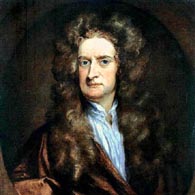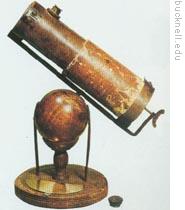VOA慢速英语 2008 1001b
时间:2019-01-11 作者:英语课 分类:VOA慢速英语2008(十)月
VOICE ONE:
This is Shirley Griffith.
VOICE TWO:
And this is Steve Ember with the VOA Special English program, Explorations. Today we tell about one of the world's greatest scientists, Isaac Newton.
(MUSIC)
VOICE ONE:

Isaac Newton
Much of today's science of physics is based on Newton's discovery of the three laws of motion 1 and his theory of gravity. Newton also developed one of the most powerful tools of mathematics. It is the method we call calculus 2.
Late in his life, Newton said of his work: "If I saw further than other men, it was because I stood on the shoulders of giants. "
VOICE TWO:
One of those giants was the great Italian scientist, Galileo. Galileo died the same year Newton was born. Another of the giants was the Polish scientist Nicholas Copernicus. He lived a hundred years before Newton.
Copernicus had begun a scientific revolution. It led to a completely new understanding of how the universe worked. Galileo continued and expanded the work of Copernicus.
Isaac Newton built on the ideas of these two scientists and others. He found and proved the answers for which they searched.
(MUSIC)
VOICE ONE:
Isaac Newton was born in Woolsthorpe, England, on December twenty-fifth, sixteen forty-two.
He was born early. He was a small baby and very weak. No one expected him to survive. But he surprised everyone. He had one of the most powerful minds in history. And he lived until he was eighty-four.
Newton's father died before he was born. His mother married again a few years later. She left Isaac with his grandmother.
The boy was not a good student. Yet he liked to make things, such as kites and clocks and simple machines.
VOICE TWO:
Newton also enjoyed finding 3 new ways to answer questions or solve problems. As a boy, for example, he decided 4 to find a way to measure the speed of the wind.
On a windy day, he measured how far he could jump with the wind at his back. Then he measured how far he could jump with the wind in his face. From the difference between the two jumps, he made his own measure of the strength of the wind.
Strangely, Newton became a much better student after a boy kicked him in the stomach.
The boy was one of the best students in the school. Newton decided to get even by getting higher marks than the boy who kicked him. In a short time, Newton became the top student at the school.
VOICE ONE:
Newton left school to help on the family farm.
It soon became clear, however, that the boy was not a good farmer. He spent his time solving mathematical 5 problems, instead of taking care of the crops. He spent hours visiting a bookstore in town, instead of selling his vegetables in the market.
An uncle decided that Newton would do better as a student than as a farmer. So he helped the young man enter Cambridge University to study mathematics.
Newton completed his university studies five years later, in sixteen sixty-five. He was twenty-two years old.
(MUSIC)
VOICE TWO:
At that time, a deadly plague 6 was spreading across England. To escape the disease 7, Newton returned to the family farm. He did more thinking than farming. In doing so, he found the answers to some of the greatest mysteries of science.
Newton used his great skill in mathematics to form a better understanding of the world and the universe. He used methods he had learned 8 as a boy in making things. He experimented. Then he studied the results and used what he had learned to design new experiments.
Newton's work led him to create a new method in mathematics for measuring areas curved 9 in shape. He also used it to find how much material was contained in solid objects. The method he created became known as integral 10 calculus.
VOICE ONE:
One day, sitting in the garden, Newton watched an apple fall from a tree. He began to wonder if the same force that pulled the apple down also kept the moon circling the Earth. Newton believed it was. And he believed it could be measured.
He called the force "gravity. " He began to examine it carefully.
He decided that the strength of the force keeping a planet 11 in orbit 12 around the sun depended on two things. One was the amount of mass in the planet and the sun. The other was how far apart they were.
VOICE TWO:
Newton was able to find the exact relationship between distance and gravity. He multiplied the mass of one space object by the mass of the other. Then he divided that number by the square of their distance apart. The result was the strength of the gravity force that tied them to each other.
Newton proved his idea by measuring how much gravity force would be needed to keep the moon orbiting 13 the Earth. Then he measured the mass of the Earth and the moon, and the distance between them. He found that his measurement 14 of the gravity force produced was not the same as the force needed. But the numbers were close.
Newton did not tell anyone about his discovery. He put it aside to work on other ideas. Later, with correct measurements 15 of the size of the Earth, he found that the numbers were exactly the same.
VOICE ONE:
Newton spent time studying light and colors. He used a three-sided piece of glass called a prism.
He sent a beam 16 of sunlight through the prism. It fell on a white surface. The prism separated the beam of sunlight into the colors of a rainbow. Newton believed that all these colors -- mixed together in light -- produced the color white. He proved this by letting the beam of rainbow-colored light pass through another prism. This changed the colored light back to white light.
VOICE TWO:

Newton's telescope used a mirror instead of a lens 17
Newton's study of light led him to learn why faraway objects seen through a telescope do not seem sharp and clear. The curved glass lenses 18 at each end of the telescope acted like prisms. They produced a circle of colored light around an object. This created an unclear picture.
A few years later, Newton built a different kind of telescope. It used a curved mirror to make faraway objects seem larger.
Light reflected from the surface of the mirror, instead of passing through a curved glass lens. Newton's reflecting telescope produced much clearer pictures than the old kind of telescope.
(MUSIC)
VOICE ONE:
Years later, the British astronomer 19 Edmund Halley visited Newton. He said he wanted Newton's help in finding an answer to a problem no one had been able to solve. The question was this: What is the path of a planet going around the sun?
Newton immediately gave Haley the answer: an egg-shaped path called an ellipse.
Halley was surprised. He asked for Newton's proof 20. Newton no longer had the papers from his earlier work. He was able to recreate them, however. He showed them to Halley. He also showed Halley all his other scientific work.
VOICE TWO:
Halley said Newton's scientific discoveries were the greatest ever made. He urged Newton to share them with the world.
Newton began to write a book that explained what he had done. It was published in sixteen eighty-seven. Newton called his book "The Mathematical Principles of Natural Philosophy." The book is considered the greatest scientific work ever written.
VOICE ONE:
In his book, Newton explains the three natural laws of motion. The first law is that an object not moving remains 21 still. And one that is moving continues to move at an unchanging speed, so long as no outside force influences it.
Objects in space continue to move, because nothing exists in space to stop them.
Newton's second law of motion describes force. It says force equals the mass of an object, multiplied by the change in speed it produces in an object.
His third law says that for every action, there is an equal and opposite reaction.
VOICE TWO:
From these three laws, Newton was able to show how the universe worked. He proved it with easily understood mathematics. Scientists everywhere accepted Newton's ideas.
The leading English poet of Newton's time, Alexander Pope 22, honored 23 the scientist with these words: "Nature and nature's laws lay hid in night. God said, --'Let Newton be!' - and all was light. "
(MUSIC)
VOICE ONE:
This Special English program was written by Marilyn Christiano and Frank 24 Beardsley. This is Shirley Griffith.
VOICE TWO:
And this is Steve Ember. Listen again next week for another Explorations program on the Voice of America.
- She could feel the rolling motion of the ship under her feet.她能感觉到脚下船在晃动。
- Don't open the door while the train is in motion.列车运行时,请勿打开车门。
- This is a problem where calculus won't help at all.对于这一题,微积分一点也用不上。
- After studying differential calculus you will be able to solve these mathematical problems.学了微积分之后,你们就能够解这些数学题了。
- The finding makes some sense.该发现具有一定的意义。
- That's an encouraging finding.这是一个鼓舞人心的发现。
- This gave them a decided advantage over their opponents.这使他们比对手具有明显的优势。
- There is a decided difference between British and Chinese way of greeting.英国人和中国人打招呼的方式有很明显的区别。
- The solution can be expressed by a mathematical equation.答案可用一个数学方程式来表示。
- Einstein was a mathematical genius.爱因斯坦是数学天才。
- Plague was then prevailing in that city.当时瘟疫正在该城流行。
- The plague once could wipe out a village.鼠疫曾一度可以夺走整个村庄村民的生命。
- The doctors are trying to stamp out the disease.医生正在尽力消灭这种疾病。
- He fought against the disease for a long time.他同疾病做了长时间的斗争。
- He went into a rage when he learned about it.他听到这事后勃然大怒。
- In this little village,he passed for a learned man.在这个小村子里,他被视为有学问的人。
- His lips curved in a barely perceptible smile. 他的嘴角弯了弯,露出一丝几乎察觉不到的笑容。
- The missile curved gracefully towards its target. 导弹呈优美的曲线状飞向目标。
- She is our best player,who is integral to our team.她是我们最好的球员,我们队离不开她。
- That's an integral part of the country.那是构成国家所必需的一部分。
- Neptune is the furthest planet from the sun. 海王星是离太阳最远的行星。
- Rubbish, however, is only part of the problem of polluting our planet. 然而, 垃圾只是我们这个星球的污染问题的一个方面。
- The space rocket was launched and went into orbit.宇宙火箭发射后进入轨道。
- We can draw the earth's orbit round the sun.我们可以画出地球绕太阳运行的轨迹。
- This orbiting telescope is the largest optical instrument in space. 这种轨道望远镜是宇宙中最大的光学仪器。 来自中级百科部分
- Let's pretend we' re on the spaceship orbiting round the earth ! 让我们假装是在沿轨道绕地球运转的宇宙飞船上!
- I can find the size of something by means of measurement.我可以用测量法求得某物的体积。
- He has made an accurate measurement of my garden.他准确地丈量了我的花园。
- The second group of measurements had a high correlation with the first. 第二组测量数据与第一组高度相关。 来自《简明英汉词典》
- In the metric system, measurements are made in metres and liters. 在公制中,用米和升作计量单位。 来自《简明英汉词典》
- The load on this beam is more than it will bear.横梁上的负荷比它能承受的要大得多。
- I could see the beam of his flashlight waving around in the dark.我可以看到他的手电筒光在黑暗中上下舞动。
- The lens of a camera forms images.照相机的镜头使图像形成。
- You should screen the lens of your camera from direct sunlight.你应该使照相机的镜头不直接照射到阳光。
- a pair of glasses with tinted lenses 一副有色镜片眼镜
- Wash the lenses in saline solution. 用盐溶液清洗镜片。
- A new star attracted the notice of the astronomer.新发现的一颗星引起了那位天文学家的注意。
- He is reputed to have been a good astronomer.他以一个优秀的天文学者闻名于世。
- He is living proof of the wonders of modern medicine.他是当代医学奇迹的活证明。
- The proof was fished up from some old papers.校样在旧文件中被找到了。
- He ate the remains of food hungrily.他狼吞虎咽地吃剩余的食物。
- The remains of the meal were fed to the dog.残羹剩饭喂狗了。
- The Pope is the spiritual leader of many Christians.教皇是众多基督徒的宗教领袖。
- The Pope is the supreme leader of the Roman Catholic Church.教皇是罗马天主教的最高领袖。
- I hope to be honored with further orders. 如蒙惠顾,不胜荣幸。 来自《简明英汉词典》
- This is a time-honored custom. 这是一个古老的习俗。 来自《简明英汉词典》